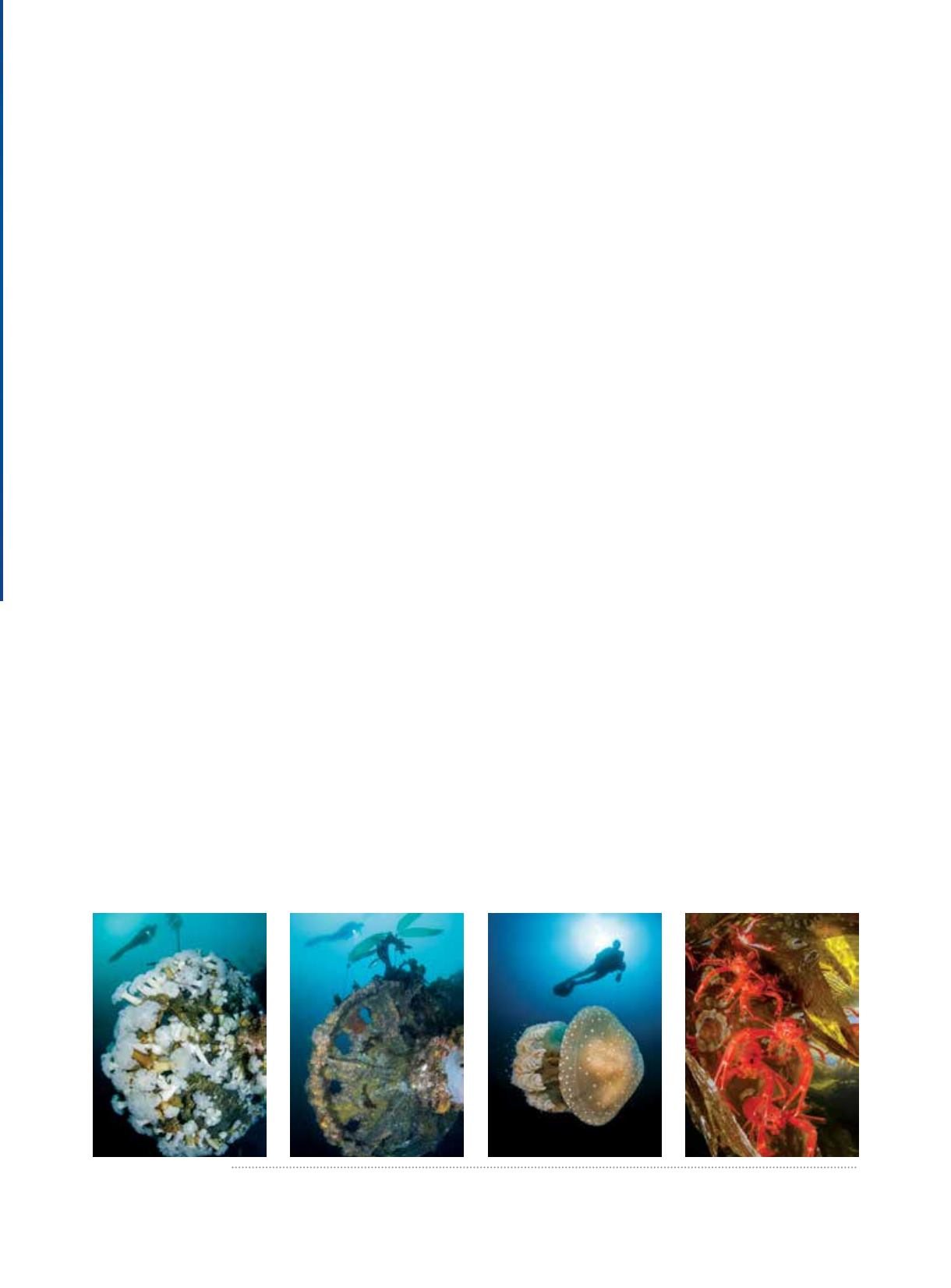

gracefully flapping among sparse kelp stalks, created a
fanatical rush on local dive charters.
By the time NOAA confirmed the arrival of El Niño
conditions in March 2015, it was hard to believe that
things could get any stranger, but they did. Sea bird
and California sea lion populations began experiencing
devastating die-offs. In April 2015, strong west-to-east
surface winds blew masses of violet-blue
Velella velella
,
open-ocean hydrozoans related to jellyfish, onto
beaches in California, Oregon and Washington. And in
June 2015 I watched in amazement as pelagic red tuna
crabs (a squat lobster-like crustacean normally found
near central Baja California) swarmed one of our few
remaining local kelp beds and ultimately littered the
coastline from San Diego to Los Angeles.
The peculiarities didn’t stop there. In July and August
2015, smooth hammerhead sharks were bumping near-
shore kayak fishermen so commonly and assertively that
local beaches were closed on multiple occasions. On
the docks, anglers posed proudly next to bluefin tuna,
caught only 10 miles offshore, and local photographs of
finescale triggerfish and Guadalupe cardinalfish became
commonplace. In September 2015, I hovered in disbelief
next to the barren propeller of the HMCS
Yukon
, a
San Diego-area artificial reef that had been thickly
encrusted with giant plumose anemones only 12 months
prior. And only a month after that, a cluster of wahoo
passed me at a Catalina Island dive site days before I
photographed a pulsing Australian spotted jellyfish
near the San Diego harbor. The world — at least, the
underwater world I frequented on a regular basis —
seemed to have gone stark raving mad.
Ed Parnell, Ph.D., research oceanographer at the
Scripps Institution of Oceanography, wasn’t terribly
surprised to hear it. “The Blob was an unprecedented
warm-water event that wasn’t related to common
oceanic indices,” he explained. “Last year we had warmer
surface conditions, but at depth things remained cold
and nutrient-rich, so some deeper species were less
affected than you might think. However, the water
became very stratified and more resistant to mixing.
Typically, an El Niño pattern results in advection of
pulses of warm equatorial water northward, so that
upwelled water is warmer than normal and less able
to deliver nutrients to shallower structures. But this
year, with things prestressed by the Blob, the seasonal
thermocline is already deeper than normal, so upwelled
water would likely be even warmer than we’ve seen with
prior El Niños — in fact, this year upwelling might not
deliver much cold, nutrient-rich water at all.”
Parnell’s key concern is further overgrowth of
invasive
Sargassum horneri
. “Two years ago, we were
seeing isolated pockets of it, but now it’s popping up
everywhere,” he said. “If we lose the kelp in an area
completely, sargassum can easily take over because it
will no longer be suppressed by giant kelp shading.”
Previous El Niño
events have delivered mighty topside
changes to the West Coast as well. In the past, the
position of the jet stream has shifted south and east
from the Gulf of Alaska so that storms track closer to
the Southern California shoreline. The strong El Nino in
1982-83 brought crippling storm fronts, complete with
waves that broke over the roofs of popular beachside
restaurants. And in 1997-98, repeated deluges washed
away roads and caused catastrophic mudslides. With
California in the midst of a drought, it feels a little
ungrateful to admit that stories of the past combined
with ever-more-ominous nicknames bestowed upon the
present El Niño
(“Bruce Lee” is my current favorite) are
more than a little frightening.
Parnell, however, says this may be one of the biggest
reasons to remain optimistic. “Strong storms can
revamp the bottom structure, remove urchin barrens
and clear out the understory kelps, providing renewed
areas for giant kelp to grow,” he said. “El Niño may bring
a series of storms, but we need to remember that those
large storms act as a reset button for kelp forests in
Southern California.”
AD
ALERTDIVER.COM|
107
From left:
The propeller of the HCMS
Yukon
wreck in San Diego’s Wreck Alley was thickly covered with giant
plumose anemones in spring 2014. By the summer of 2015, the ocean had become warm enough to wipe
them out, leaving nearly bare metal behind. A diver pauses over an Australian spotted jellyfish near the coast
of San Diego. Pelagic red tuna crabs, a denizen of Baja, Mexico, swarmed a California kelp bed in June 2015.
















